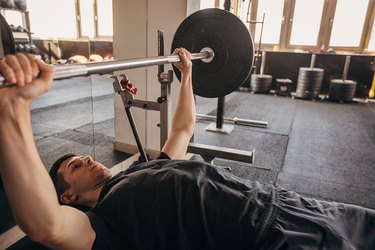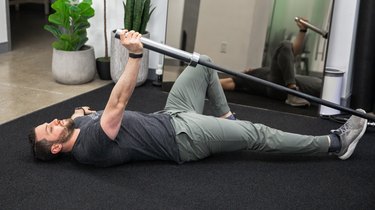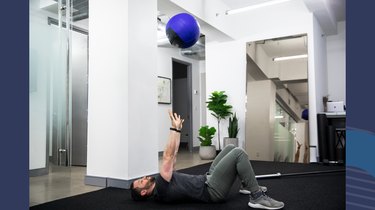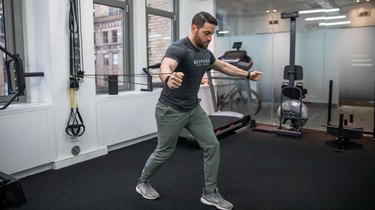
The barbell bench press is known as the crème de la crème of chest exercises. Unfortunately, that means most gyms' bench presses are always crowded. And adding a station to your at-home gym can be expensive — and take up a lot of space.
Lucky for you (and your pecs), there are plenty of great alternatives to bench press exercises that you can do in the gym or at home. Plus, they are more than just a good plan B. By working your chest, shoulders and triceps in unique, challenging ways, they can help you build a stronger, more balanced upper body than you can with bench presses alone.
Video of the Day
"Like many other muscles in the body, working your chest from different angles and planes of movement helps develop fuller, more well-rounded looking chest muscles," Joel Freeman, CPT, a Beachbody trainer and creator of LIIFT4 training program, tells LIVESTRONG.com. "The key is to not stick with only one exercise, but continue to challenge the different areas of your chest with different movement patterns."
During your next upper-body lifting session, give these 11 bench press substitutes a try.
Body-Weight Bench Press Alternatives
1. Push-Up
Push-ups are a top no-gear alternative to bench presses, says Sam Becourtney, DPT, CSCS, a New York-based physical therapist and strength coach.
"With push-ups, you're using the same muscles to propel your body away from the floor instead of a bar away from your body," he says.
As you do this exercise, don't let your elbows flare straight out to your sides, says certified personal trainer Carolina Araujo, CPT. This push-up mistake makes the move less effective and can cause injury, too.
Push-Up
- Get in a high plank with your core and glutes squeezed. Your shoulders should be stacked over your wrists and your hips should be in line with your head and heels.
- Bend your elbows at a roughly 45 degree angle from your torso and lower your chest toward the floor.
- As you lower, squeeze your shoulder blades down and together. Don't let your shoulders scrunch up toward your ears.
- When your chest hovers just above the floor (or however far down you can comfortably go), press into the bench to return to the starting position.
2. Incline Push-Up
If you can't do a full push-up, the modified incline push-up is the best place to start. This exercise strengthens your chest, shoulders and triceps.
It also doubles as a phenomenal core exercise. Think of it as a moving plank.
Incline Push-Up
- Place your palms on an exercise bench or the seat of a chair.
- Walk your feet back until you're on your toes.
- Come into a high plank with your core and glutes squeezed.
- Bend your elbows at a roughly 45 degree angle and lower your chest toward the bench.
- As you lower, squeeze your shoulder blades down and together. Don't let your shoulders scrunch up toward your ears.
- When your chest hovers just above the bench (or however far down you can comfortably go), press into the bench to return to the starting position.
3. Decline Push-Up
When push-ups are no longer a challenge, add a decline. Raising your feet loads your chest, shoulders and arms with a greater percentage of your body weight. That means you have to push more weight with each rep.
Decline Push-Up
- Place your palms on the floor in front of an exercise bench or the seat of a chair.
- Walk your feet back and step them onto the elevated surface.
- Come into a plank with your core and glutes squeezed.
- Bend your elbows at a roughly 45 degree angle and lower your chest toward the floor.
- As you lower, squeeze your shoulder blades down and together. Don't let your shoulders scrunch up toward your ears.
- When your chest hovers just above the floor (or however far down you can comfortably go), press into the bench to return to the starting position.
Related Reading
Dumbbell Bench Press Alternatives
1. Chest Press
One big downside of the barbell press? It's easy to favor your left or right side, which can add to any muscle imbalances, according to Becourtney. The dumbbell chest press forces your arms to work individually. You can't rely on your dominant side to carry the bulk of the weight.
You won't be able to press as much weight with dumbbells as you can with a barbell, but that's cool. The dumbbell variation is harder to keep steady and works your stabilizing muscles that much harder, Araujo says.
Chest Press
- Lie on your back on a weight bench (or the floor) with a dumbbell in each hand. Hold the weights with straight arms above your chest. Plant your feet firmly on the floor and tighten your abs.
- Bend your elbows at a roughly 45 degree angle from your torso and lower the weights until they are in line with your chest. Your forearms should stay vertical.
- Press the weights back up over your chest.
Tip
"Make sure to focus on keeping dumbbells in line with middle of your chest, instead of your neck and shoulder area," Freeman says.
2. Chest Fly
Your chest muscles don't just press. They also hug. The dumbbell fly strengthens your hug, technically called horizontal shoulder adduction. The move also strengthens the pec muscles when they're in a stretched position, Becourtney says. This helps strengthen your chest through its full range of motion for better shoulder mobility.
When you do this exercise, keep the weights as controlled as possible and lower the dumbbells slowly with each rep.
Chest Fly
- Lie down on a bench (or the floor) holding a dumbbell in each hand directly over your chest. Your elbows should be slightly bend and your palms should face each other.
- Keeping the bend in your elbows, lower the dumbbells to the sides of your chest until you feel a gentle stretch (not pull or pain) in your chest.
- Exhale as you reverse the motion and use your chest muscles to pull the dumbbells back to start.
Tip
"It’s very important to focus on keeping the weights in line with middle of chest and not shoulders or neck," Freeman says.
Related Reading
3. Incline Chest Press
Because you're at an angle during this variation, you hit the upper part of your chest, says certified personal trainer Jen Widerstrom, CPT, head transformation coach for Transformation Protein's 60-Day Total-Body Challenge.
"This is optimal for anyone looking to change up their chest routine, or is living with a bit of rotator cuff pain and looking for more shoulder girdle support," she says.
Incline Chest Press
- Lie down on a bench at a slight incline. Place your feet flat on the floor.
- Hold a dumbbell in each hand above your chest, just wider than shoulder-distance apart.
- Squeeze your glutes (but don't lift them off the bench) and drive your feet into the floor as you press the weights up and slightly back over your head. Press until your elbows are straight. Your forearms should stay vertical at all times.
- Lower the weights back down to your chest with control.
Tip
No bench? No problem. Widerstrom recommends doing this exercise with your upper back and shoulders against a couch, chair or other sturdy object.
"In a successful incline bench, the three most important points of contact are your feet, hips and upper back, all of which are contact points when incline pressing against a couch," she says. "To reinforce position stability, I encourage you to gently breathe in air into your diaphragm as the weights descend and exhale pulling your bellybutton toward your spine as you press up."
4. Incline Chest Fly
Like the incline chest press, an incline dumbbell fly puts extra attention on your upper pecs while the muscles lengthen from side to side.
This exercise isn't as easy as it looks, Araujo says. Start with light weights and nail your form before lifting heavier. If you feel wobbly, walk your feet wider apart for extra balance support, she says.
Incline Chest Fly
- Lie face-up on an incline bench adjusted to about 45 degrees, holding a dumbbell in each hand above your shoulders, palms facing each other.
- With a slight bend in your elbows, slowly lower the weights down toward the sides of your chest. Your elbows should come to about shoulder level.
- Raise your arms back up to the starting position, squeezing your chest at the top.
5. Decline Chest Press
This bench press alternative exercise focuses on your lower pectoral muscles to help prevent muscle imbalances.
If you don't have a decline bench. Don't worry. You can do a decline chest press from a glute bridge with your shoulders and feet flat on the floor and hips raised.
Decline Chest Press
- Lie down on a bench at a slight decline, holding a dumbbell in each hand directly over your chest. Your elbows should be slightly bend and your palms should face each other.
- Keeping the bend in your elbows, lower the dumbbells to the sides of your chest until you feel a gentle stretch (not pull or pain) in your chest.
- Exhale as you reverse the motion and use your chest muscles to pull the dumbbells back to start.
Tip
For a full chest circuit, do a chest press, chest fly and decline press for 3 sets of 10 reps each with a 15-second break between exercises, Freeman says.
6. Decline Chest Fly
This dumbbell fly variation targets the lower segments of your chest muscles. Use a lighter weight than you use for the flat chest fly. The combination of decline and gravity makes this a challenging chest exercise.
Again, if you don't have a decline bench available, you can use a glute bridge to get into position.
Decline Chest Fly
- Lie face-up on an incline bench adjusted to about 45 degrees, holding a dumbbell in each hand above your shoulders, palms facing each other.
- With a slight bend in your elbows, slowly lower the weights down toward the sides of your chest. Your elbows should come to about shoulder level.
- Raise your arms back up to the starting position, squeezing your chest at the top.
7. Single-Arm Chest Press
This version of the dumbbell chest press is a one-sided (unilateral) exercise. Unilateral training is an excellent way to build muscle on each side of the body equally, helping reduce the likelihood of imbalances and injuries, according to the American Council on Exercise (ACE).
This single-arm press is also a fantastic anti-rotation core exercise, according to Becourtney. As you move one weight at a time, you'll feel your body want to tilt or roll to one side. Don't let it.
With this lift, you can alternate arms or do all of your reps on one side and then switch, Araujo says.
Single-Arm Chest Press
- Lie on your back on a weight bench (or the floor) with a dumbbell in each hand. Hold the weights with straight arms above your chest. Plant your feet firmly on the floor and tighten your abs.
- Holding the left arm in place, bend your right elbows and lower the weight until it's in line with your chest.
- Press the weight back up over your chest.
- Alternate sides.
Gym Equipment Bench Press Alternatives
1. Landmine Single-Arm Chest Press
If you can't set up a barbell for a traditional bench press, try a landmine exercise.
Lying on the floor with a landmine builds more core and shoulder stabilization than using a standard barbell bench press does. But it's doesn't require as much coordination and control as dumbbell variations, Becourtney says.
Landmine Single-Arm Chest Press

- Secure a barbell in a landmine or corner.
- Lie down on the floor with the free end of the barbell in line with the right side of your chest.
- Bend your left knee, bringing the foot flat to the floor.
- Extend your left arm to your side for extra balance.
- Hold the end of the barbell with your right hand.
- Keeping your legs straight and left arm at your side, press the barbell straight up over your chest.
- Lower back down until your right elbow lightly taps the floor and press the bar back up.
- Do all reps, then switch sides.
2. Medicine-Ball Chest Pass
"This is a great variation to work on power and plyometric development of the pecs and upper chest by throwing a ball as high as you can and also controlling the catching portion of the movement, while on your back (against gravity)," he says.
Upper-body plyometric exercises not only improve your power and strength, but can boost calorie burn and coordination, according to the ACE.
Start with a light, soft medicine ball for this exercise until you're more confident with the movement. The last thing you want is a heavy med ball falling on your chest (or face)!
Medicine-Ball Chest Pass

- Start by lying on the ground with a soft medicine ball in your hands.
- Bend your knees and place your feet flat on the ground.
- Keeping your core braced and back flush against the floor, throw the ball up into the air straight over your chest.
- Catch the ball softly on the way down.
3. Band-Resisted Split-Stance Chest Fly
When you're at the gym, you can skip the free-weight area and go straight to the cable machines or resistance bands. The cable and band-resisted chest fly exercises work the muscles differently than dumbbells do.
The cable machine provides the same amount of resistance throughout the entire exercise, while resistance bands get harder the more you stretch them, Becourtney says.
Band-Resisted Split-Stance Chest Fly

- Start by anchoring a resistance band at about chest height.
- Grab a handle in each hand and face away from the anchor.
- Take a few steps away from the anchor and set up a split stance with your left foot slightly in front of the right.
- Move your right foot a few inches off to the right for better balance.
- Extend your arms to your sides with your elbows slightly bent.
- Keeping the slight bend in your elbows, draw the handles to meet in front of your body at chest level.
- Reverse the motion and return to the starting position.
Was this article helpful?
150 Characters Max
0/150
Thank you for sharing!
Thank you for your feedback!